Lu Shengzhong (1952–2022)
By Sharpe Xie, Pamela Wong

Portrait of LU SHENGZHONG. Courtesy Chambers Fine Art, New York / Beijing.
Lu Shengzhong, a leading Chinese contemporary artist known for his “little red figures” and a beloved professor at Beijing’s Central Academy of Fine Arts (CAFA), died on the afternoon of October 26, at the age of 70. After suffering an asthma attack, he was immediately sent to the intensive care unit, but died after being hospitalized for more than ten days.
Lu was born to a peasant family in the village of Dayuji in Pingdu, Shandong Province, on January 4, 1952. During the Cultural Revolution, Lu joined the army in 1969 and was assigned to the film projection team, where he started drawing slideshows and displaying them before screening a film. After the Cultural Revolution, Lu enrolled in the art department of Shandong Normal University in 1976, primarily making traditional paintings and silkscreen prints. When preparing for a show in Shandong, he found New Year paintings intriguing and started learning more about folk art.
In 1984, Lu joined the postgraduate program at CAFA. Influenced by the rise of ’85 New Wave, which liberated art-making in China, he often traveled to northern Shaanxi to collect visual elements rooted in traditional Chinese folk art including the New Year paintings. He created his first “little red figure” there when learning how to cut and make zhuaji dolls (also known as “soul-summoning dolls,” which are red paper-cut dolls that symbolize life, reproduction, and luck) from a group of old women in one of the villages. He started to use this symbol to delve into the trajectory of soul and self-discovery, which gradually became his most frequently explored theme in his oeuvre.
Veteran artist Xu Bing and art historian Yin Jinan were his classmates and closest friends during their postgraduate studies and the trio was known as “The Three Musketeers of CAFA.” In October 1988, Lu and Xu held their first solo exhibitions concurrently at the National Art Museum of China, which showcased Lu’s paper art and Xu’s woodcut prints. Yin penned a review titled “The Turning Point of Chinese Contemporary Art” for both shows, which also marks the beginning of his career as an art writer.
In Lu’s 1990 installation Hall of Calling the Soul, where he filled a CAFA studio with thousands of his paper-cut red dolls, he finalized the symmetrical, frog-like shape of his “little red figures”: their arms stretch upward with their legs wide open, as if they are standing upright connecting heaven and earth. Each figure represents a soul, with his meditative, creation process—the circling movement of his scissor—symbolizing the cycle of life and death. This visually haunting work gained him reputation as a paper-cutting artist and in the following years, he created different iterations of Calling the Soul as well as other works featuring the iconic red figure. In Munich in 1993, for example, he curated a Soul Market, where customers could take away the red dolls and insert coins into a box as they wish, as an attempt to reflect on people’s “perceived price of the soul.”
In the early 2000s, he began exploring other cut patterns using red and black paper, and juxtaposed the pieces into a collage or binding them using traditional Chinese methods. These experiments were crystalized in a 12-meter-tall paper installation shown at his solo exhibition “The New Emerging From the Old” in 2005. Titled The Book of Humanity – The Empty Book, the work weaves together bundles of paper cuts into three red scrolls, suspended from the ceiling of the art museum of the University at Albany.
After obtaining his master’s degree from CAFA, Lu stayed at the academy and was responsible for teaching at its folk-art studio. In 1992, during a study trip to a German art school, Lu had the idea to bring the avant-garde concepts of teaching in Western art education back to China. He was appointed by CAFA to establish the department of experimental art in 2004, the decade-long development of which was showcased in an exhibition at CAFA in 2014. Speaking of Lu’s diligence, Xu Bing recounted, “I visited him once and was surprised to see his bed, bookshelves, and his own collected pieces laid around in his university office! He was too hardworking.”
Lu exhibited extensively worldwide, with solo exhibitions held in China, United States, Germany, Australia, Japan, Russia, and Taiwan. His last major survey was “Last Century” at Beijing’s Today Art Museum in 2015–16.
CAFA’s official WeChat platform published a series of tributes written by 26 art professionals. Alongside his best friends Xu and Yin were writings by artist Qiu Zhijie, art curator and critic Feng Boyi, as well as his former students Li Yang, Wu Jian’an, and Ai Wan.
Pamela Wong is ArtAsiaPacific’s associate editor; Sharpe Xie is editorial intern.







